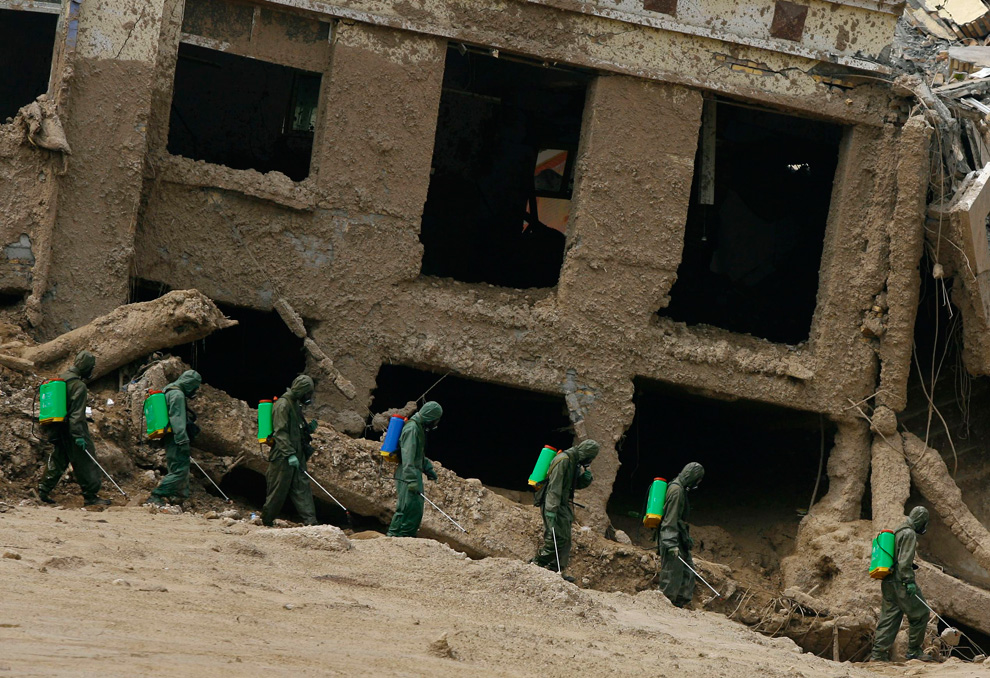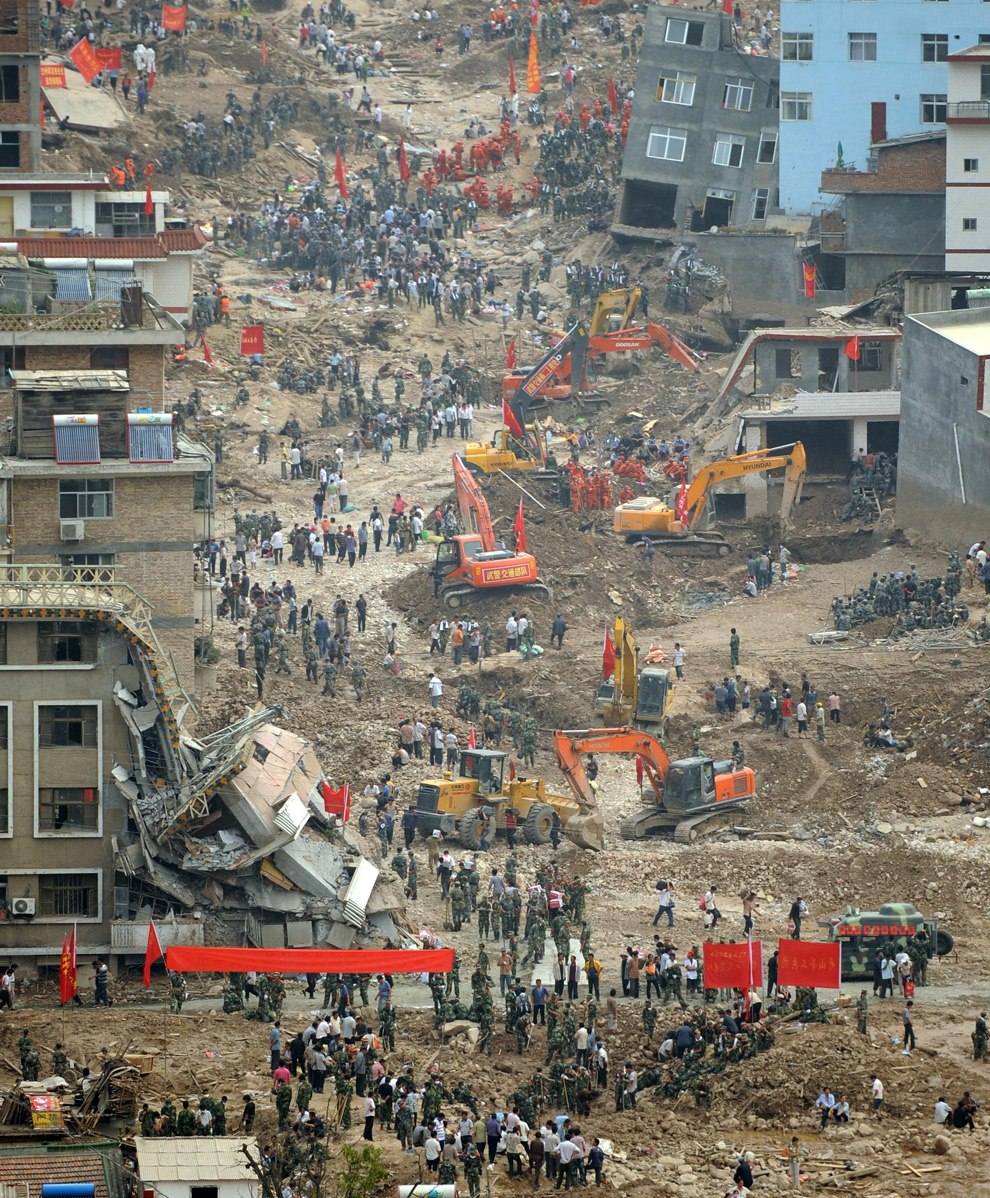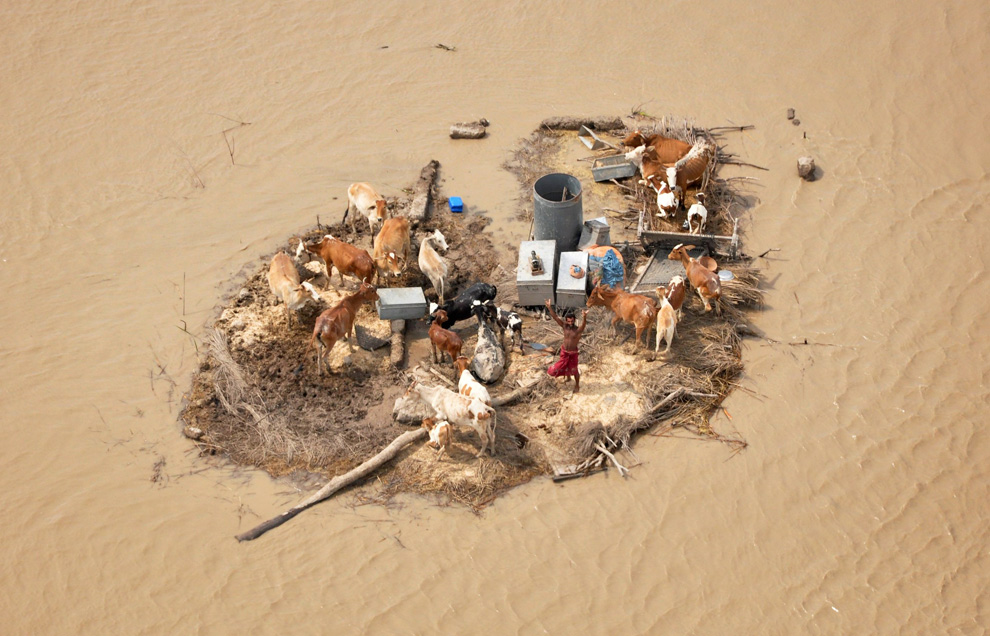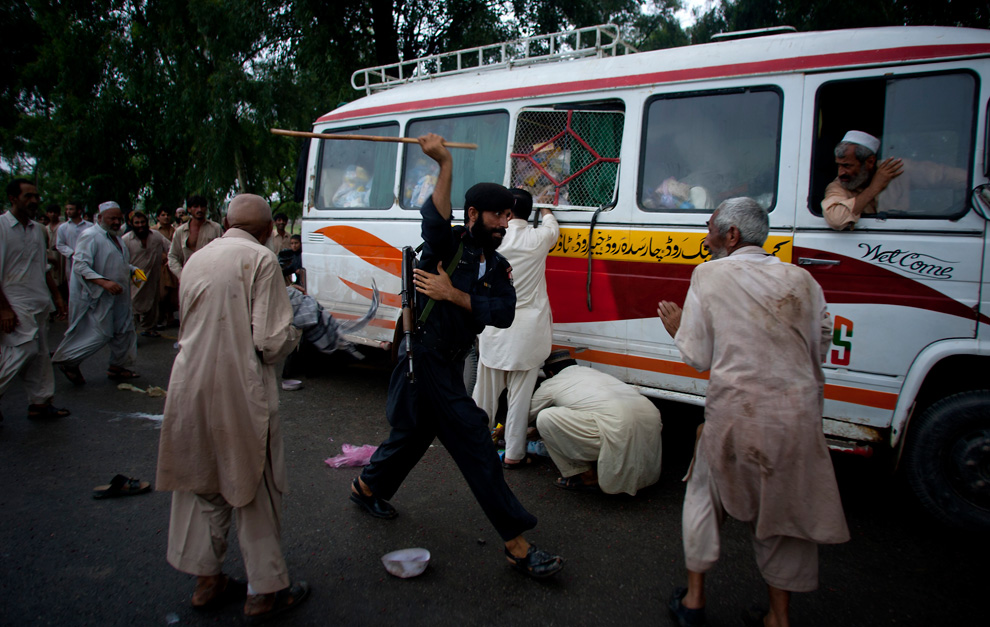Notes
Beyond "Compassion Fatigue": A Tale of Two Cities
It has been a summer of catastrophes, both natural and man made. There are pictures aplenty, and in some measure they all depict a similar and recurring story of tragedy, death and destruction, first responders, clean-up, and mourning, all of which rely upon a common set of visual tropes and conventions to make their point. Those who decry “compassion fatigue” have plenty to support their claims, but if we look closely we might see differences that warrant less knee jerk reactions. As a case in point, consider two slideshows featured in tandem at The Big Picture concerning the floods in Pakistan and the mudslide in Zhouqu County, China.
The mudslide resulted in over 1,100 deaths (and counting). In the above photograph we see a platoon of workers disinfecting a street in front of a building that was demolished by the slide. The image is marked by two complementary features. First, is the contrast between the drab tones of the mud encrusted building and the bright green canisters that contain the disinfectant being sprayed. Second, is how carefully these state workers—soldiers actually—seem to be going about their task: dressed in protective gear, their attention focused on the ground in front of them, their movements are almost entrained as they work in unison to destroy the breeding grounds of infection and disease. Taken en toto we have a representative image of the Chinese government’s response to the disaster: the carefully coordinated use of state resources and modern technology to address the immediate needs precipitated by a crisis situation. The point is reinforced in a second representative photograph:
This is a more panoramic image of the destruction and devastation, shot from above, but once again note how the orange and yellow cranes and earth movers underscore not just the presence of modern technologies, but the capacity of the state to organize and coordinate their usage quickly and somewhat effectively. And note too that both state workers and civilians appear to be working in tandem. China is governed by a totalitarian regime, make no mistake about that, but such images indicate one of the sources of its internal legitimacy: when push comes to shove the state mobilizes its considerable resources to respond to crisis situations with some dispatch. We have seen it before (here and here). And whatever we might find objectionable in China’s commitment to human rights—and there is plenty—this is not a feature of its government that should be ignored or scanted. Indeed, it deserves emulation.
In contrast, consider some of the photographs that depict the recent floods in Pakistan. The Big Picture begins with this image:
Here we have a Pakistani man literally marooned on an island in the midst of flood waters. What distinguishes him from the animals with which he shares this tiny piece of land is the demand he is placing on his viewers for assistance. And as the caption to the image tells us, he is appealing to an “Army” helicopter for relief. There is nothing here to indicate that this particular helicopter belongs to the U.S. government, though other pictures in the slide show make the implication clear enough. But the bigger point to be made is how alone and isolated the man is, literally separated and apart from those with whom he supposedly shares a social contract. Numerous other photographs in the slide show underscore the sense of isolation and social fragmentation that appears to govern Pakistani society in the wake of what is without a doubt a monumental crisis, suggesting the sense in which this image is something of a representative anecdote for the immediate underlying problem that confronts Pakistan.
That sense of isolation and social disconnection is reinforced by other photographs in the slideshow, and not least by those few images that picture a thoroughly inadequate State response. The Pakistani military has something of a vague presence in a few of the photographs we are shown, but even there their efforts are isolated, individuated, and apparently inadequate, as implied by the larger and more active presence of the U.S. military. And the one place where we see a distinctively active Pakistani state, the effect is hardly salutary:
A Pakistani police officer is pummeling a fellow citizen with a baton for “looting” donated food. On the face of it the looter doesn’t seem to be all that much of a threat. To be sure, order needs to be maintained, perhaps all the more so in times of crisis, but beating an already weakened citizenry in need of food hardly seems to be an appropriate response. Perhaps this is an isolated incident. Maybe this lone police officer felt overwhelmed by a mob of looters and reacted to a felt threat. Maybe. But again, the bigger point is how the photograph functions as a cipher for a society in total disarray and a government that doesn’t seem to have a clue as to how to proceed in the modern world—or perhaps imagines its legitimacy as nothing more than a function of brute force and doesn’t worry about the need to achieve any legitimacy by effectively administering its society. This may or may not be an accurate characterization of Pakistani society and governance, but the contrast with how China appears to respond to crisis and catastrophe could not be more pronounced.
It is of course important to keep in mind that the magnitude of the catastrophe in Pakistan dwarfs the recent disaster in China. The mudslides in China effect one county and thousands of people, the floods in Pakistan will effect nearly fourteen million people. And yet, even for all of that, it is hard not to see a tale of two cities envisioned here, one animated by a modern government dedicated to effective response to crisis, large or small, and the other thoroughly inadequate to the demands of life in modern times.
Photo Credits: STR/AFP/Getty, Reuters, AP Photo/Anjum Naveed






Reactions
Comments Powered by Disqus